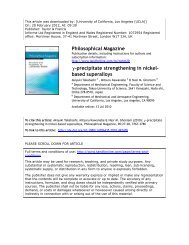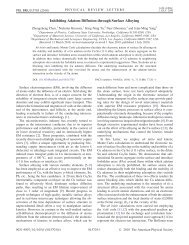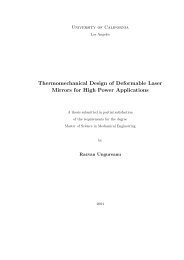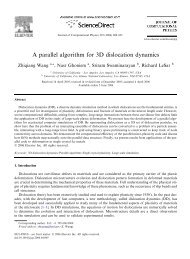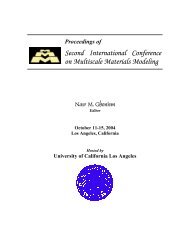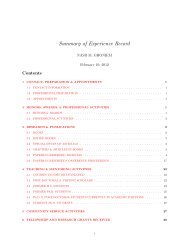FS&T Template - Nasr Ghoniem's Matrix Laboratory - UCLA
FS&T Template - Nasr Ghoniem's Matrix Laboratory - UCLA
FS&T Template - Nasr Ghoniem's Matrix Laboratory - UCLA
Create successful ePaper yourself
Turn your PDF publications into a flip-book with our unique Google optimized e-Paper software.
Sharafat et al.<br />
100% dense CVD SiC with a high modulus of 412 GPa<br />
(high stiffness), and (2) the FCI foam panels exert stresses<br />
due to their thermal expansion which concentrates along<br />
the upper and lower edges of the foam panels. The high<br />
thermal resistance between the bracket and the foam panel<br />
causes the highest temperature gradients to occur near the<br />
FCI foam panel edges. This exacerbates the stresses in the<br />
brackets. This analysis indicates that improved thermal<br />
heat transfer coefficient between the bracket and the FCI<br />
foam panels are desirable to reduce temperature gradients<br />
near the support brackets.<br />
Figure 10 also plots the detailed localized stress<br />
levels along the inside edge between bracket and FCI<br />
foam panel. Stress levels in the FCI foam/CVD structure<br />
are above the tensile stress limit (~120 MPa) for unirradiated<br />
CVD SiC materials, with stresses in the bracket<br />
material being about 10 MPa to 20 MPa higher. These<br />
results indicate that the bracket design has to be modified<br />
in order to reduce stresses. Potential reduction in stress<br />
levels may be achieved, by rounding of all edges and<br />
changes and by changing bracket geometry.<br />
SiC-FOAM BASED FLOW CHANNEL INSERT FOR DCLL TBM<br />
in Figure 11 (Ref. 5). The maximum temperatures along<br />
the FCI structure occurs toward the top (exit) of the FCI,<br />
in addition, the temperature distributions are not<br />
symmetrical nor are the uniform.<br />
Fig. 11: Temperature contour maps of FCI surfaces: (a)<br />
behind FW (inside the FCI); (b) behind FW (outer); (c)<br />
back of the FCI (inner); (d) back of the FCI (outer).<br />
Fig. 10: Thermal stress contours of the SiC-Foam Based<br />
FCI segment; also shown are the stresses along the edge<br />
between the SiC bracket and CVD SiC face sheet.<br />
IV.B. Full-length FCI Thermo-Mechanical Response<br />
Based on 3-D magnetohydrodynamic calculations,<br />
detailed temperature distributions along the inside and<br />
outside faces of the entire 1.3 m long FCI structure were<br />
developed for typical ITER operations, which are shown<br />
This results in non-uniform thermal gradients across the<br />
FCI structure, which differ significantly from the simple<br />
uniform temperature conditions used to investigate a<br />
single segment (Fig. 8 Fig. 10). Figure 12 shows the<br />
results of the thermal analysis of the full length FCI<br />
structure. Temperatures along the FCI range from a low<br />
of 343 o C at the inlet to 427 o C at the outlet. The<br />
temperature gradient across the FCI structure at the exit is<br />
between 30 o C and 40 o C, while at the bottom the gradient<br />
is less than 15 o C.<br />
In calculating the stress distributions, we considered<br />
as a primary load the pressure head of PbLi along the 1.3<br />
m height of the FCI. The maximum pressure load is of the<br />
order of 0.1 MPa exerted at the bottom and from the<br />
inside of the FCI. We did not include any pressure<br />
difference between the inside and outside of the FCI<br />
structure, because these estimates were not available. The<br />
von Mises stress contours of the combined thermal plus<br />
pressure loads are shown in Fig. 13. The maximum<br />
stresses of about 66 MPa occur above the mid-plane of<br />
the FCI on the FCI panel and behind the bracket. The<br />
stresses do not vary greatly as a function of FCI height, in<br />
fact most of the FCI structure experiences relatively<br />
uniform stress levels, ranging between 20 MPa and 50<br />
MPa, with the lowest stresses occurring at the brackets.<br />
The combined von Mises stresses in the FCI structure<br />
made of SiC-foam sandwiched between CVD SiC face<br />
sheets and supported by CVD SiC brackets are below the<br />
allowable stress levels of for CVD SiC (~120 MPa).<br />
FUSION SCIENCE AND TECHNOLOGY VOL. 56 AUG. 2009 889



